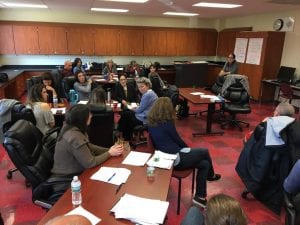The Science Leadership Team conducted inter-school and class visits using the Instructional Rounds Model K-12. Science teachers from throughout the district visited classrooms ranging from kindergarten at WOS to Honors Chemistry at TZHS and everything in between. The focus question was “How do students express their understanding of three Science Standard Crosscutting Concepts–Patterns, Cause and Effect, and Stability and Change–that they are learning?” The Science Leadership teachers noticed these themes running throughout every class.
The focus question was “How do students express their understanding of three Science Standard Crosscutting Concepts–Patterns, Cause and Effect, and Stability and Change–that they are learning?” The Science Leadership teachers noticed these themes running throughout every class.
WOS teachers observed kindergarten students following a task list about the weather. Students partook in various activities such as building shelters to protect animals from various types of weather, writing and recording weather reports like meteorologists and writing about how various weather types change the things that they can do outside. First-graders illustrated their ability to pull facts from video resources and connect them together as evidence to the patterns of the sun.
CLE teachers were able to see the third grade students form hypotheses based on previous observations to allow their wheels to roll faster and farther than their previous attempts. Students asked, “Does the angle of the ramp make it go farther?” “How about where the wheels are placed along the axle?” Students were excited to test these hypotheses and more to see which change would cause their wheels to roll the farthest. Our fourth-graders continued the t rend by testing their predictions about how to create circuits to make a motor run and which materials would conduct the electricity to allow the motor to continue to work. They discovered that the material was the cause for their varying results.
rend by testing their predictions about how to create circuits to make a motor run and which materials would conduct the electricity to allow the motor to continue to work. They discovered that the material was the cause for their varying results.
Our SOMS students were contemplating how the angle of the light from the sun hitting our surface affects the temperatures on Earth. They made hypotheses based on previous observations and research and then performed an experiment to test out their theories. Other students studying astronomy read about how China was proposing to build an artificial moon to light up the night sky in order to cut down on electricity bills at night. However, the article proposed that scientists were worried about the effect this might have on the nocturnal animals. Do you think it’s worth the risk?
on electricity bills at night. However, the article proposed that scientists were worried about the effect this might have on the nocturnal animals. Do you think it’s worth the risk?
TZHS teachers were able to observe students engaged in various lessons  that focused on data analysis and graphs. Students were able to evaluate the data in these graphs to determine trends in patterns in the various properties of elements and solve puzzles using relationships found on the periodic table.
that focused on data analysis and graphs. Students were able to evaluate the data in these graphs to determine trends in patterns in the various properties of elements and solve puzzles using relationships found on the periodic table.
During our analysis of the rounds, the teachers highlighted the many opportunities the students were given to collaborate and discuss their ideas and predictions. We noticed that students were in charge of their learning by using task lists, choosing how they presented what they had learned and also with whom they partnered. The team discussed how the next steps would be to make these cross cutting themes more visible to the students and connect one unit to another through these themes. We also want to review the other four cross-cutting concepts to see how they are illustrated throughout the curriculum. We look forward to continuing this work throughout the school year.
Thank you again to all those teachers who graciously hosted our leadership team in their classrooms. We learned a great deal from your students.
